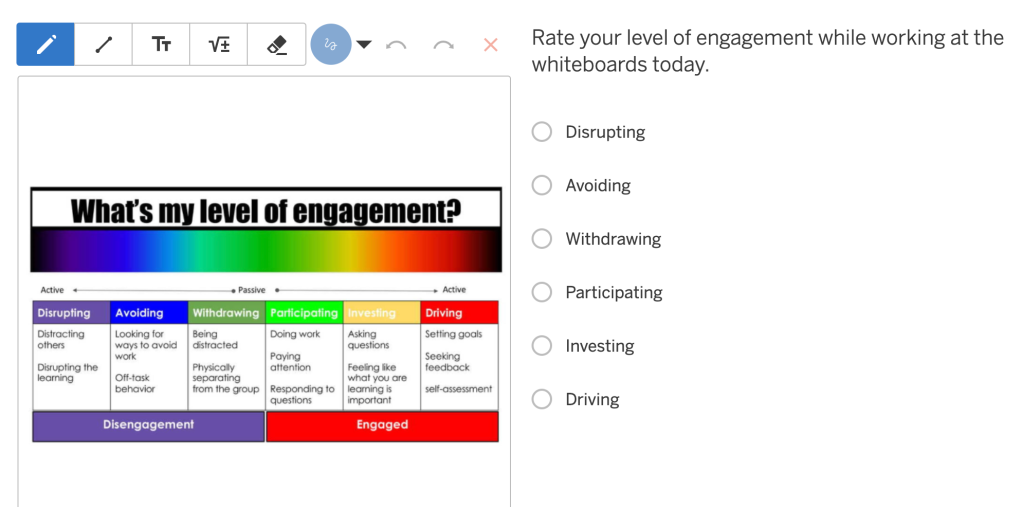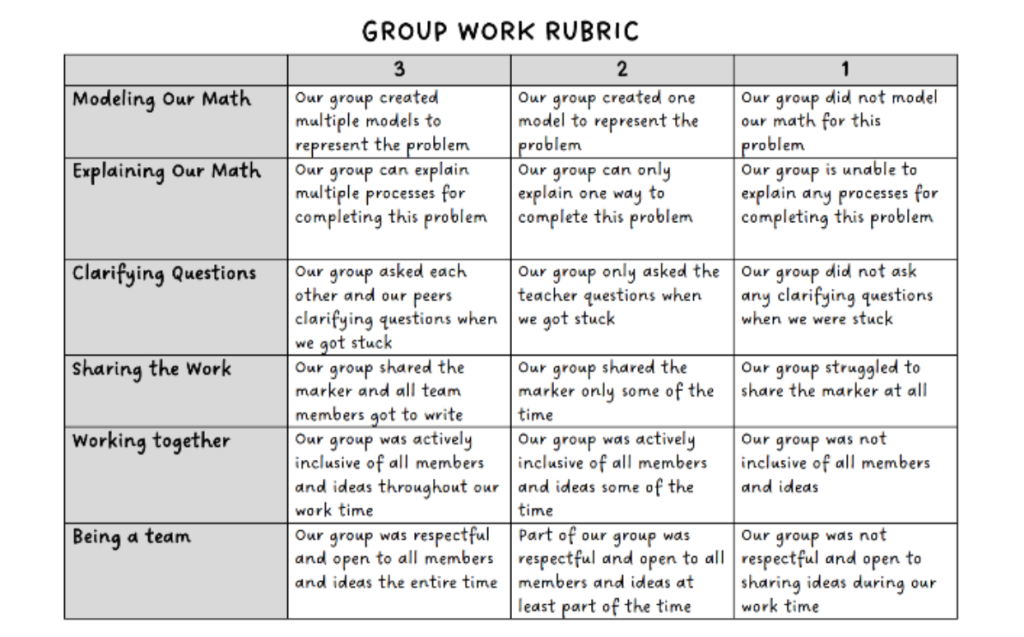My middle school students have been in class for about two weeks. The first few days were spent creating a classroom community, completing name tents, and building norms related to expectations at the whiteboards. Over the two weeks students have worked on whiteboard around seven times. The first week it was all non-curriculular tasks and during the second the team shifted towards curricular-specific tasks – we are exploring area. The focus this year has been to start the year emphasizing strategies out of the Building Thinking Classrooms book. I believe classes are making progress with their whiteboard work and this post will summarize what’s been happening so far.
One of the first things that my team did related to whiteboard work was to create expectations for what was to happen during tasks. After non-curricular tasks students filled out this reflection sheet in a Desmos deck.
Students rated their engagement level and filled out a rubric. I reviewed the curated data with the class to help develop the norms, although I already had some ideas in mind. One of my math department team members found the below image while visiting social media communities related to BTC,
The ideas worked well with the norms that the class picked so we went with this. I posted a copy of this above image the whiteboards for students to reference.
For the most part, I’ve been following a similar routine with whiteboard tasks. This is a general routine and it varies depending on the lesson. Students enter the room, I take attendance, review the overarching goal, I give a brief mini-lesson on the topic and use a slide deck to introduce a specific topic. If the lesson involves manipulatives then we use them in our table groups to help build a better understanding on the topic. I then pass out playing cards ( I only use Ace-10) and show the task statement on the whiteboard. Students head to the whiteboards and begin working. The tasks last around 10 – 15 minutes before I ask them to send one spy out to review the work of others. Students return back to their groups and then finish up their work on the board. Usually I consolidate as a whole class and we visit different boards to review and reflect. Students take a picture of their whiteboard and put it in their math folder along with a caption in Notability. Then students fill a digital reflection sheet.
Wins:
Students are engaged in mathematical thinking . I’ve observed students talking with one another and debating ideas before putting the marker to whiteboard. That discussion seems to help students flesh out ideas and explain their thinking clear enough for their partners to understanding. Standing at the whiteboards seems to help student stay engaged more than sitting. Groups are sharing the markers. It didn’t start this way, but having one marker per group and sticking to that rule helps ensure that there’s more collaboration in the group as the ideas are spread. I’ve also noticed that students are increasing their mathematical thinking stamina while in groups – needed as students are now in middle school and the expecations are higher. Prolonged attempts at making sense of a problem and attempting a solution while in a group is more evident as students become more familiar with the whiteboard routines. I’ve also observed that students are becoming more comfortable with sharing their ideas with others when a spy comes to visit their group. When we first started sometimes students would hide their work. The ideas of knowledge mobility is becoming more common place and that’s a win.
Questions:
I still have questions though. Not everyone is on task and I still find some students distance themselves away from the group and allow others to do the heavy lifting. I noticed that some groups are waiting to complete all of their work untill a spy is sent out to retrieve hints or an answer. This has me questioning how often I send out the spy directions. I’m also still having issues with giving too many hints or asking students specifically direct questions to help move them in the right direction. Students are used to a different atmosphere in the math classroom so this is an adjustment. I’m aso working on becoming better during the consolidation process – especialliy when it comes to getting everyone back together and engaging in synthesis at the end of the whiteboard process. One last thing. My classes haven’t been assessed yet on the skills we’ve been addressing so I wonder how they’ll perform? My hope is that they’ll take what we’ve been learning and apply it thoroughly on the common assessment.
I’m looking forward to refining my own practice as the year continues. Feel free to ask questions or add your own experiences to this post. We’re all in this together!




Hey Matt! Just shared this with a new friend who wants to strengthen BTC practice! Great reflections!
LikeLiked by 1 person
Thank you for reading, Mary. I hope the reflection helps friend.
LikeLike